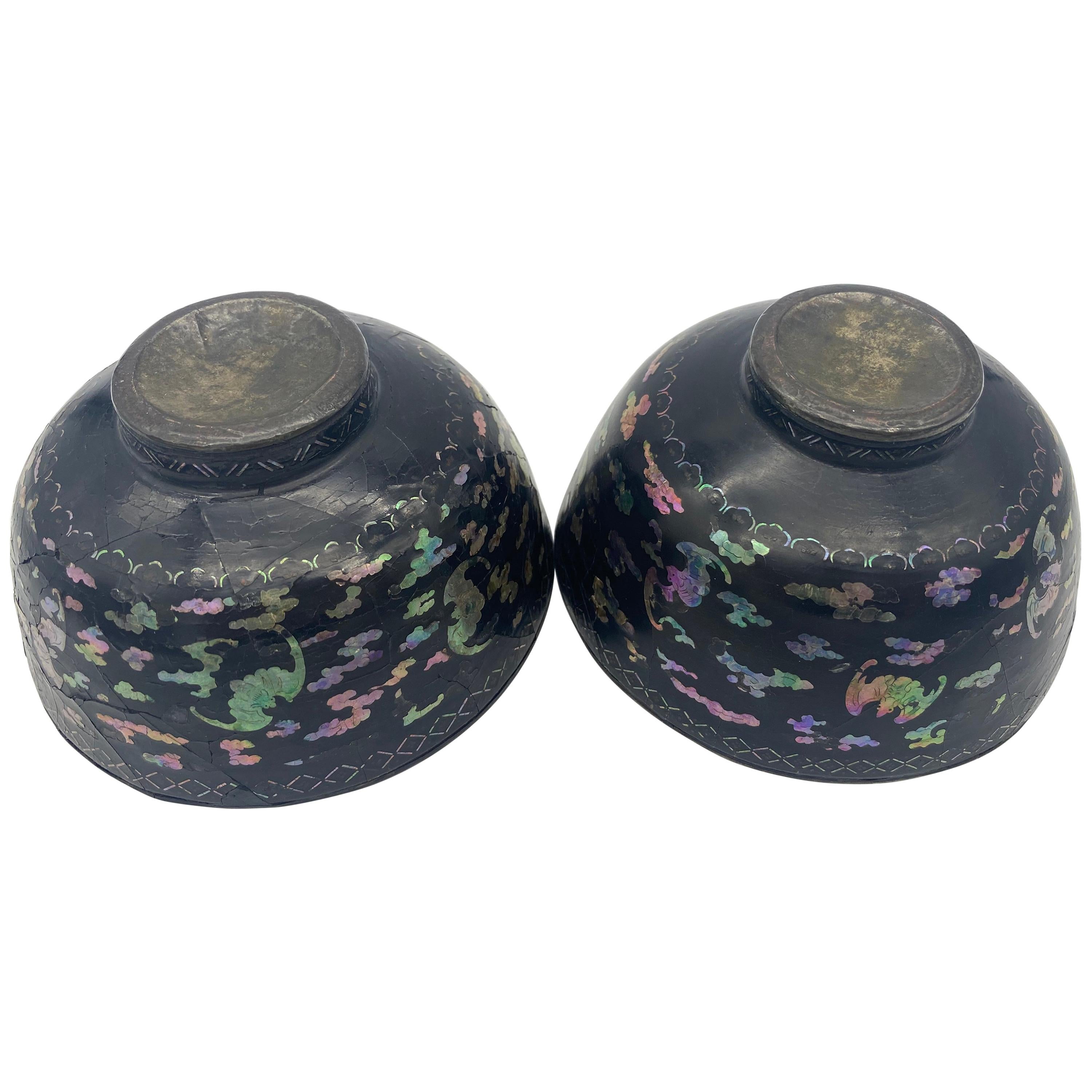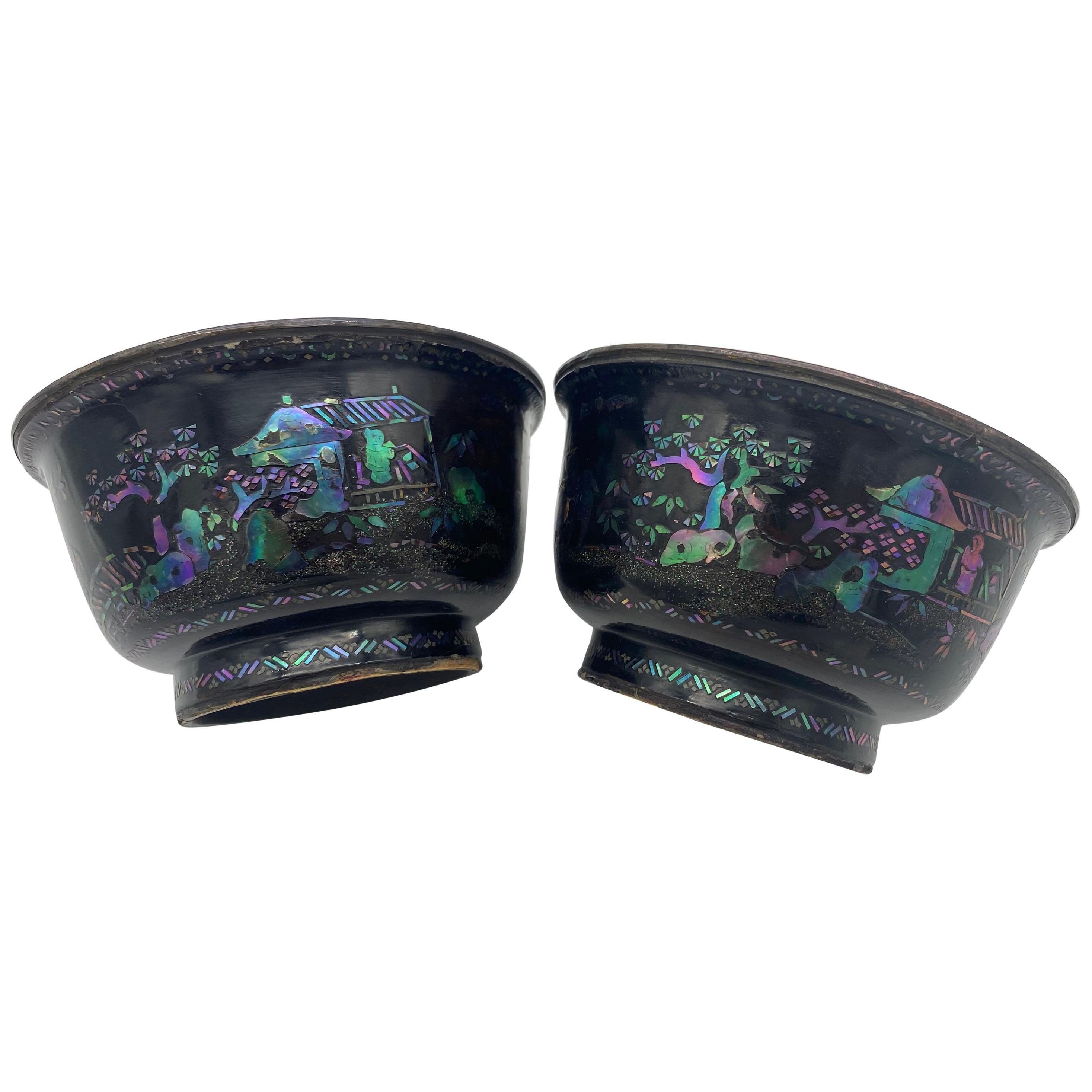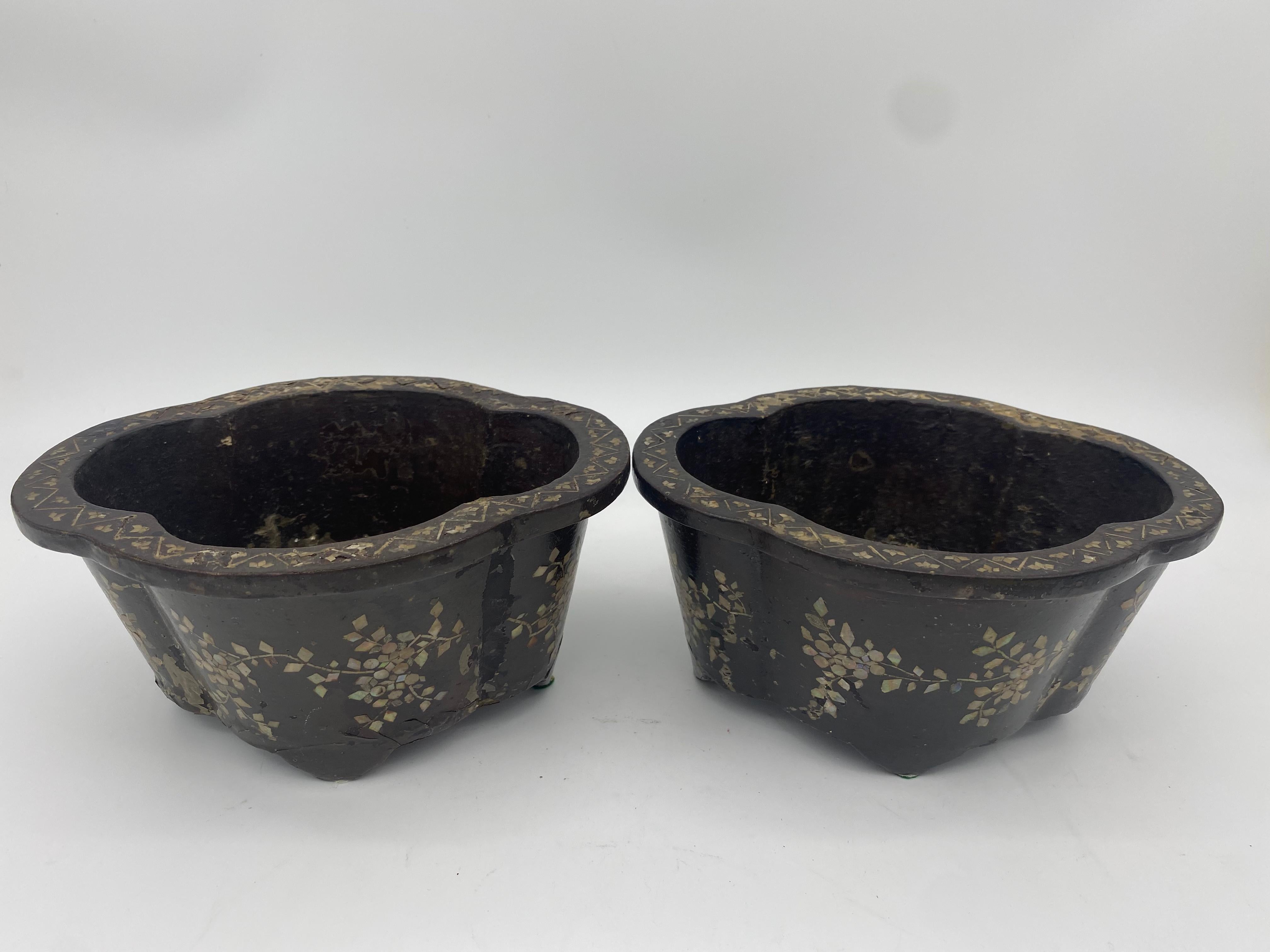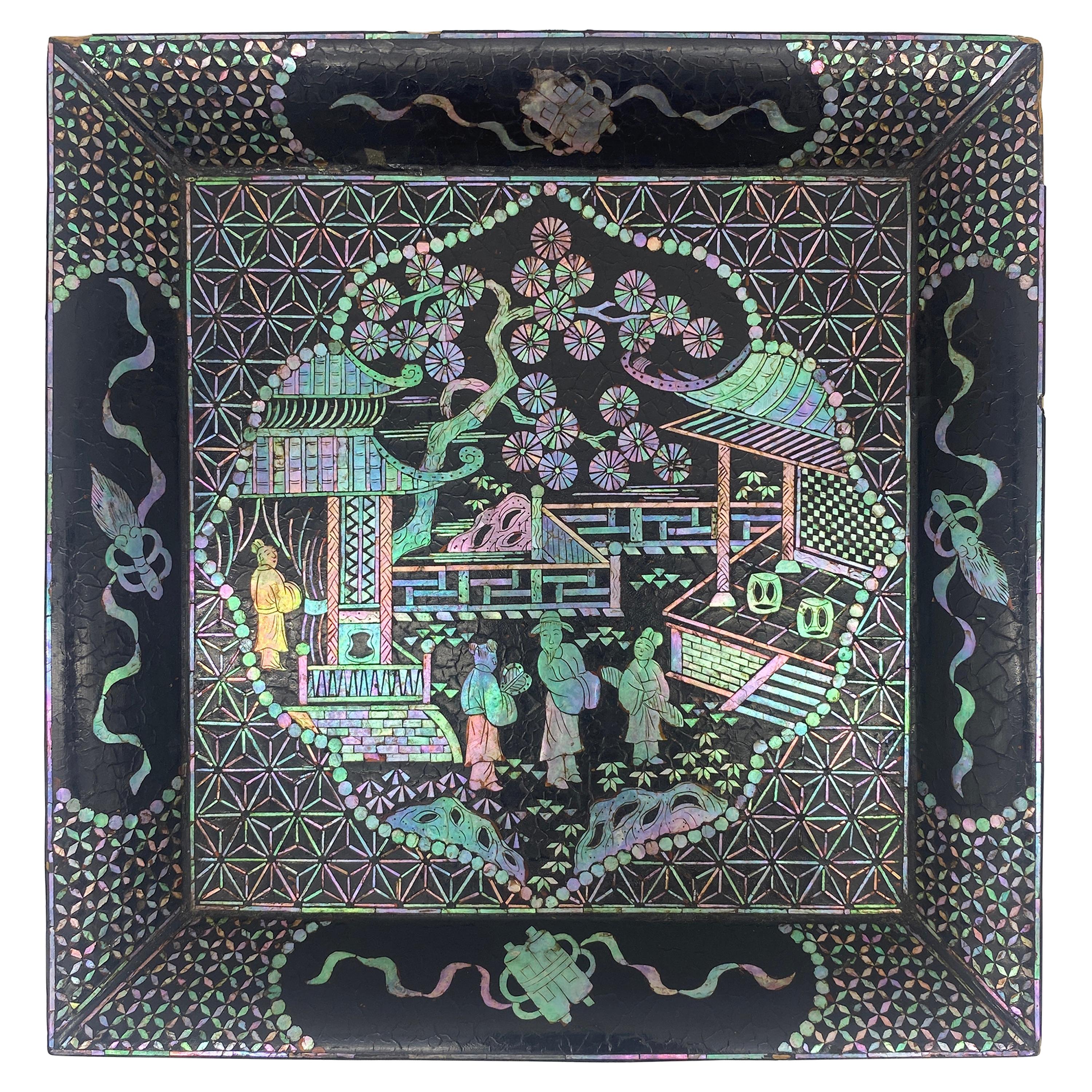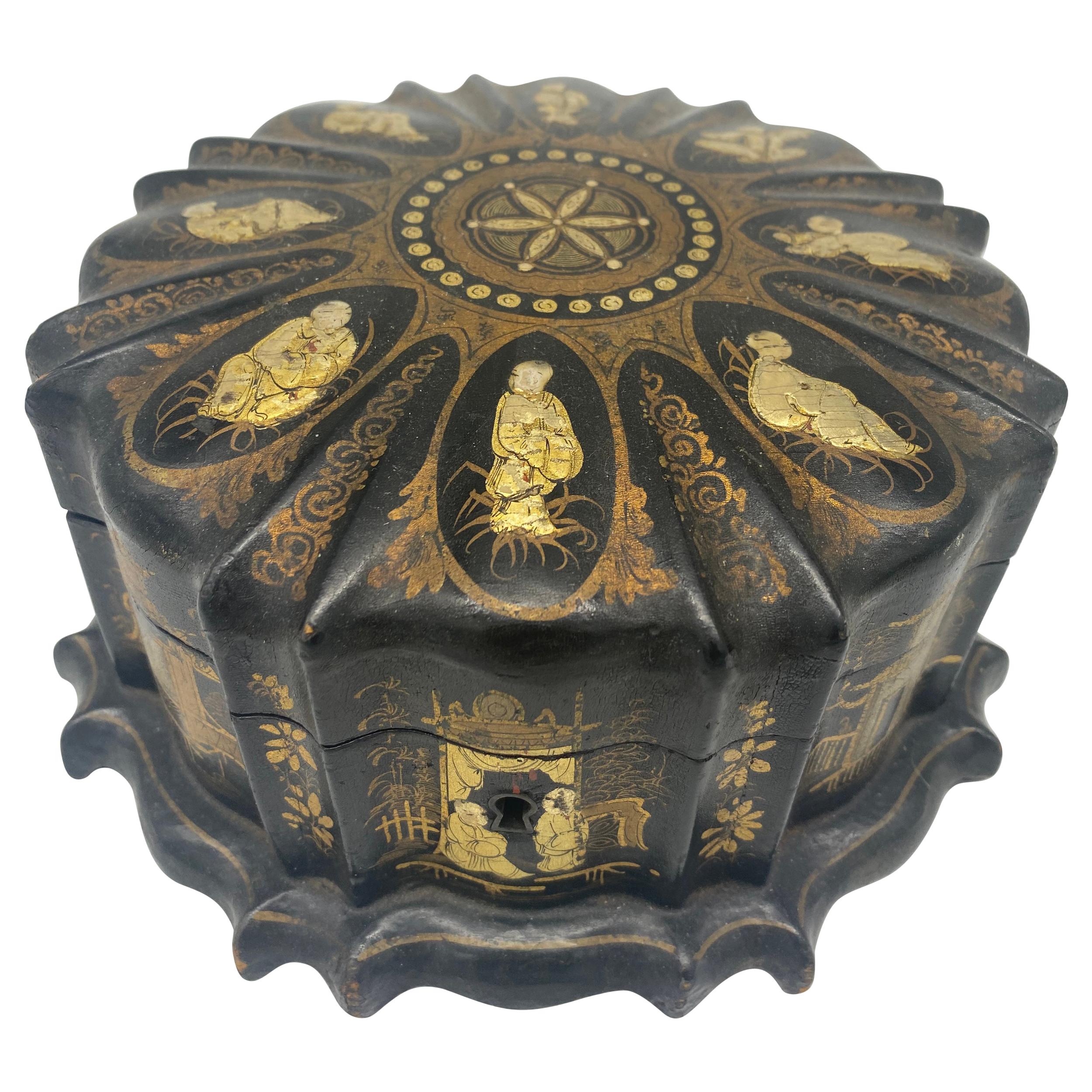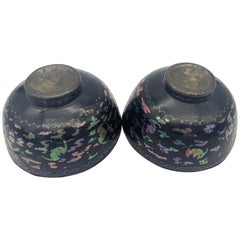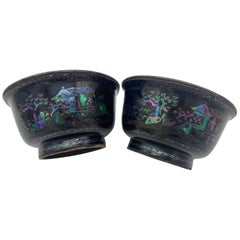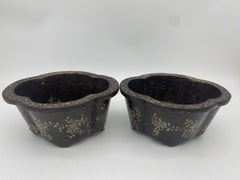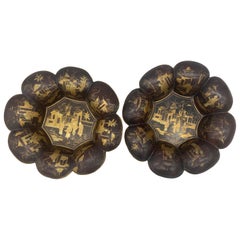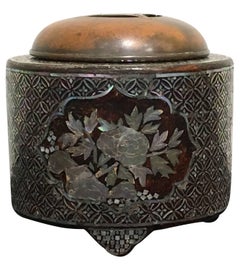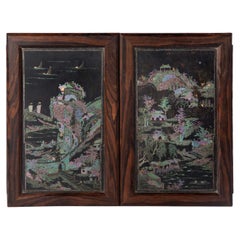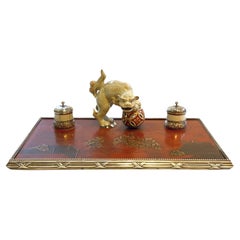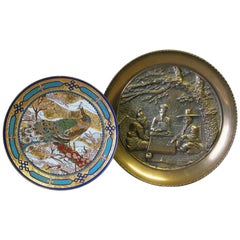Items Similar to 17th Century Pair of Chinese Silver Lacquer Plates with Mother of Pearl
Want more images or videos?
Request additional images or videos from the seller
1 of 18
17th Century Pair of Chinese Silver Lacquer Plates with Mother of Pearl
$12,280
£9,309.93
€10,731.88
CA$17,294.41
A$19,178.22
CHF 10,076.73
MX$234,325.27
NOK 126,073.67
SEK 118,341.68
DKK 80,115.62
About the Item
Pair of Chinese silver, lacquer, and mother of pearl plates from the 17th century. A matching pair of ornamental antique Chinese plates, the faces each of a thin sheet of distressed silver over a body of black lacquered wood with mother of pearl inlays representing traditional style Chinese buildings and figures in a wooded stony environment, the base of the feet also with a protective thin sheet of silver. Condition: Both in good condition with some tarnish to the silver and age related wear.
- Dimensions:Height: 1.75 in (4.45 cm)Diameter: 9.875 in (25.09 cm)
- Style:Qing (Of the Period)
- Materials and Techniques:Lacquer,Lacquered
- Place of Origin:
- Period:
- Date of Manufacture:17th Century
- Condition:Wear consistent with age and use.
- Seller Location:Brea, CA
- Reference Number:1stDibs: LU5292219333782
About the Seller
4.6
Vetted Professional Seller
Every seller passes strict standards for authenticity and reliability
1stDibs seller since 2020
62 sales on 1stDibs
Typical response time: 12 hours
- ShippingRetrieving quote...Shipping from: Brea, CA
- Return Policy
Authenticity Guarantee
In the unlikely event there’s an issue with an item’s authenticity, contact us within 1 year for a full refund. DetailsMoney-Back Guarantee
If your item is not as described, is damaged in transit, or does not arrive, contact us within 7 days for a full refund. Details24-Hour Cancellation
You have a 24-hour grace period in which to reconsider your purchase, with no questions asked.Vetted Professional Sellers
Our world-class sellers must adhere to strict standards for service and quality, maintaining the integrity of our listings.Price-Match Guarantee
If you find that a seller listed the same item for a lower price elsewhere, we’ll match it.Trusted Global Delivery
Our best-in-class carrier network provides specialized shipping options worldwide, including custom delivery.More From This Seller
View All18th Century Pair of Chinese Silver Lacquer Bowls with Mother of Pearl Inlaid
Located in Brea, CA
Pair of Chinese silver, lacquer, and mother of pearl burgaute "Bat " bowls, each inlaid in mother of pearl with bats in flight amongst stylized clouds between a band of cash to the r...
Category
Antique 18th Century Chinese Qing Lacquer
Materials
Lacquer
18th Century Pair of Chinese Silver Lacquer Bowls with Mother of Pearl Inlaid
Located in Brea, CA
Pair of Chinese silver, lacquer, and mother of pearl big bowls from the 18th century. The faces each of a thin sheet of distressed silver over a body of black lacquered wood with mot...
Category
Antique 18th Century Chinese Qing Lacquer
Materials
Lacquer
19th Century Pair of Lacquer Chinese Jardinières Inlay with Mother of Pearl
Located in Brea, CA
19th century a pair of black lacquer Chinese jardinières inlay with mother of pearl, with loss to lacquer and inlay throughout, each 7.25 inches wide,...
Category
Antique Late 19th Century Chinese Qing Antiquities
Materials
Lacquer
19th Century Pair of Golden Black Lacquer Chinese Plates
Located in Brea, CA
19th century a pair of lift-lid gilt-decorated golden black lacquer Chinese plates, very beautiful pieces. every plate with 4 golden feet.
Category
Antique Early 19th Century Chinese Qing Antiquities
Materials
Lacquer
18th Century Black Lacquer Mother of Pearl Inlay Plate
Located in Brea, CA
18th century black lacquer mother of pearl inlay plate, decoration as expected for age and use. Very beautiful and hard to find li...
Category
Antique Early 18th Century Chinese Qing Antiquities
Materials
Mother-of-Pearl
19th Century Chinese Lacquer Jewelry Box
Located in Brea, CA
19th century Qing Dynasty Chinese lacquer jewelry box detailed with various genre scenes in gold detail. Pink silk lining, can be locked, does not ...
Category
Antique 19th Century Chinese Qing Lacquer
Materials
Lacquer
You May Also Like
Japanese Edo Period Lacquer and Mother-of-Pearl Embellished Stoneware Koro
Located in Austin, TX
A highly unusual Japanese crackle glazed koro (incense burner or censer), lacquered and inlaid with mother-of-pearl embellishment, signed Gyokusen, Ed...
Category
Antique 19th Century Japanese Edo Scholar's Objects
Materials
Copper
Pair of Mother- of- Pearl Inlaid Laquer Table Screens Qing Dynasty, 18th Century
Located in Amsterdam, Noord Holland
A pair of very high quality mother of pearl plaques made into a writing table. In the same family since 1900. Plaques dating to the 18th century, most likely Kangxi and later mounted...
Category
Antique 18th Century Chinese Paintings and Screens
Materials
Porcelain
Chinese Lacquer Porcelain and Silver Inkwell
Located in New York, US
Our charming inkwell features a finely sculpted porcelain foo dog standing on lacquered wooden panel with two silver ink vessels with their original porcelain cups. Hinge of one wel...
Category
Antique Late 19th Century Chinese Qing More Asian Art, Objects and Furni...
Materials
Silver
Very Decorative Chinese Champlevé Enamel Plate in a Japanese Style
Located in Ottawa, Ontario
A very decorative Chinese champlevé enamel plate in a Japanese style, vividly enameled with a peacock amidst flowering prunus branches and endless kno...
Category
Mid-20th Century Chinese Chinese Export Metalwork
Materials
Enamel
Chinese Qing Lacquered and Inlaid Handled Sewing Box
Located in Bishop's Stortford, Hertfordshire
An unusual and fine antique Chinese Qing lacquered and inlaid papier mache handled sewing box with decorative panels dating from latter 19th or early 20th century. The sewing box is of round cylindrical shape with a swing carry handle and is inlaid with mother of pearl and abalone. The body is made up of eight oval shaped scenes of typical Chinese style with buildings and people picked out with inset abalone and mother of pearl and highlighted and contained within a gilded border. These are set between bands of patterned abalone and against a blue silk background. A similar band of abalone is applied to the swing handle. The cover sits within a recess and is made up of bands on inset abalone with cut out triangular designs and set over blue silk with a small finely carved mother of pearl handle...
Category
Antique 19th Century Chinese Qing Lacquer
Materials
Abalone, Mother-of-Pearl, Silk, Lacquer
Large Chinese Enamel Bronze Cloisonne Charger
Located in Norwood, NJ
Large Chinese enamel bronze cloisonne charger. Unusual and rare bronze Chinese Cloisonne charger. The brightly multicolored enamel decoration feature...
Category
Late 20th Century Chinese Metalwork
Materials
Bronze, Enamel
More Ways To Browse
Antique Chinese Silver
Antique Chinese Plate
Mother Of Pearl Plate
Black Lacquer Chinese
Asian Black Lacquer Furniture
Black Lacquer Mother Of Pearl
Mother Of Pearl Inlay Lacquer
Chinese Mother Of Pearl
Antique Asian Mother Of Pearl Furniture
Antique Chinese Mother Of Pearl Furniture
Chinese 17th Century Plate
Black Lacquer Mother Of Pearl Inlay Furniture
Chinese Furniture With Mother Of Pearl Inlay
Chinese Lacquer Mother Of Pearl
Chinese Lacquer And Mother Of Pearl
Asian Black Lacquer Pearl Furniture
17th Century Pearl
Chinese Lacquer Plate
